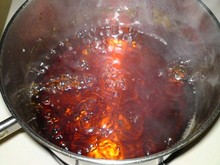
It is probably best added toward the end of the boil, but a portion of the sugar can be added to the fermenter as well, just be sure that it was stored properly and you are confident that it's sterile.
Boiling sucrose for a while in water causes some of the disaccharide sucrose molecules to split (invert) into the monosaccharides glucose and fructose. Some recipes call for the inclusion of an acid to aid the inversion process, but the importer assured me that the only ingredient in his product is refined beet sugar (sucrose).
Once some of the sugar is inverted holding it at around 285 presumably allows some of the newly created fructose to caramelize (caramelization temp of 220), while the more robust sugar molecules glucose (caramelization temp of 300) and sucrose (caramelization temp of 340) remain intact and more importantly fermentable.
The final addition of water allows the finished sugar to remain liquid at room temperature, making it much easier to add to a beer than lumps of solid sugar.
Check out the following link for step-by-step instructions and pictures. [Read More]
(Credit goes to The Mad Fermentationist for the original research and providing the information above)
